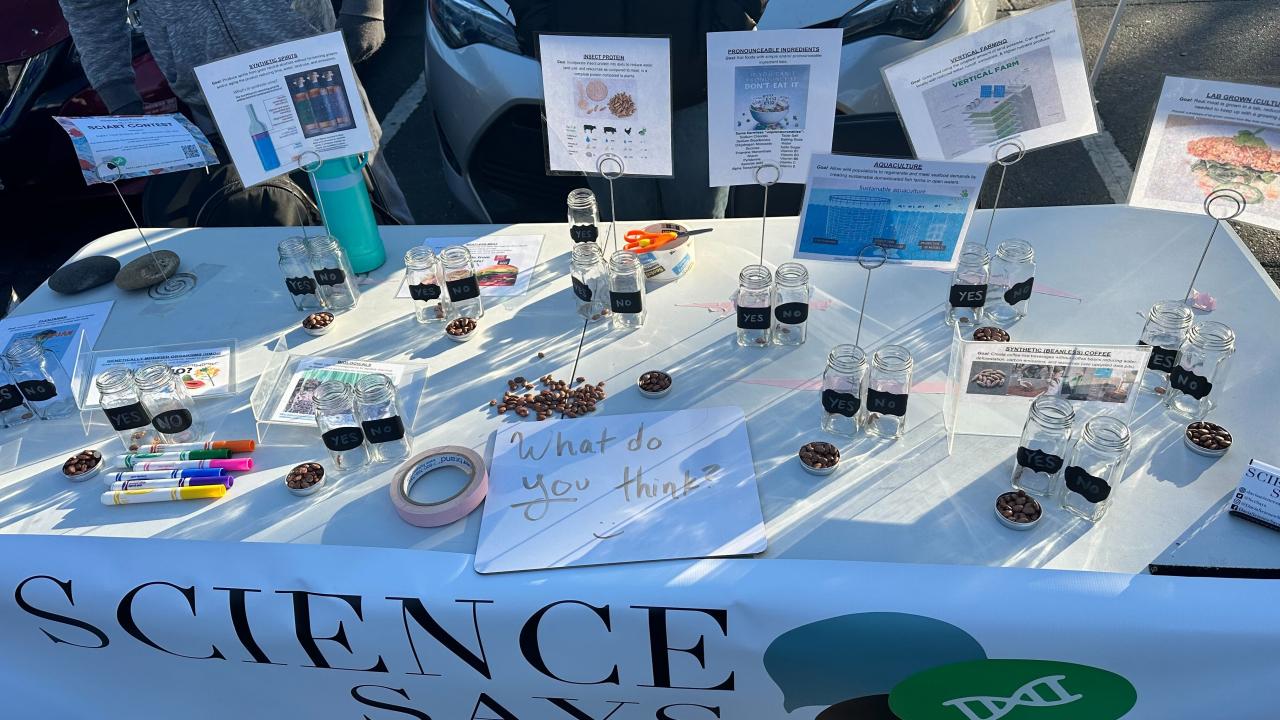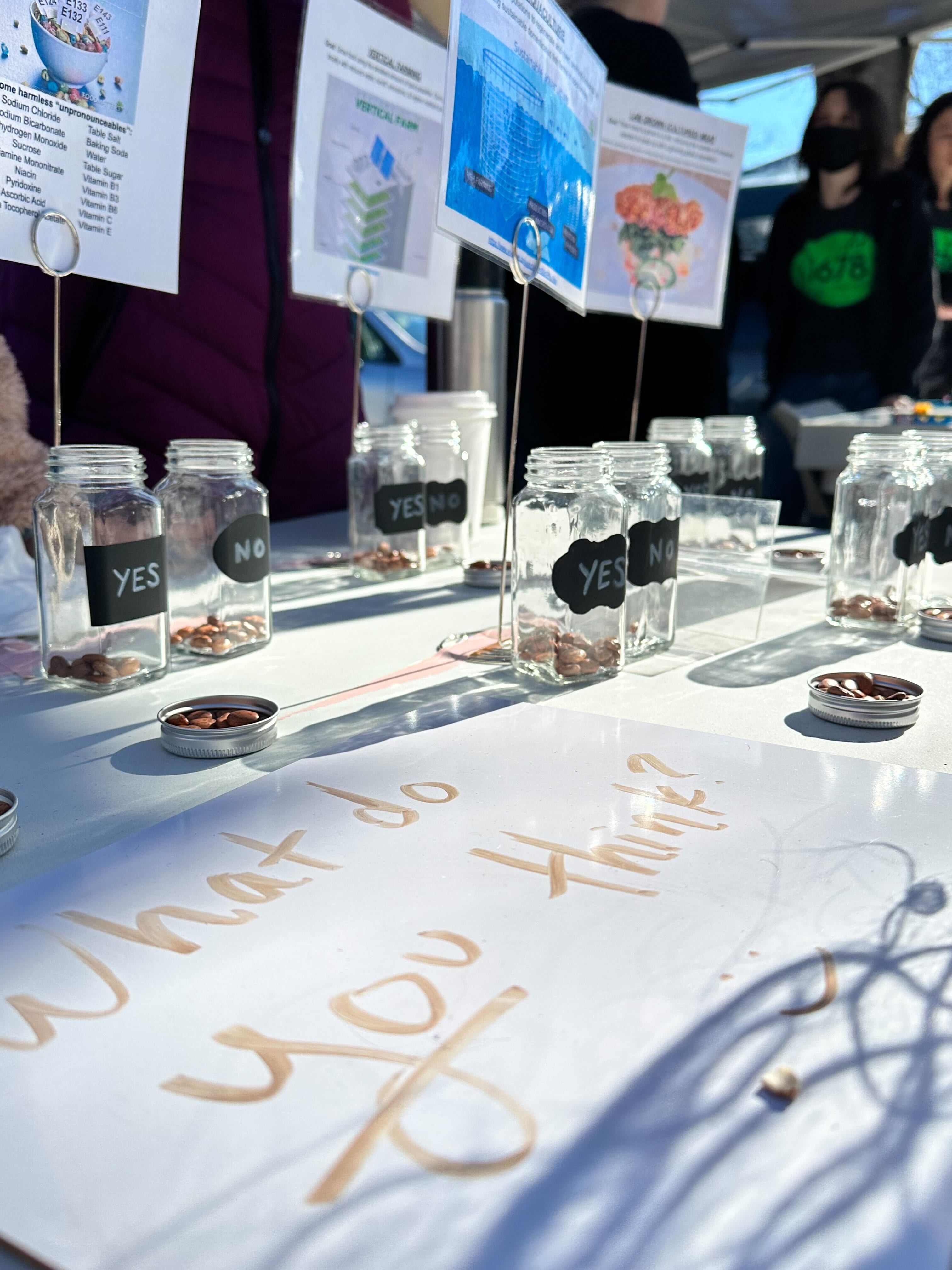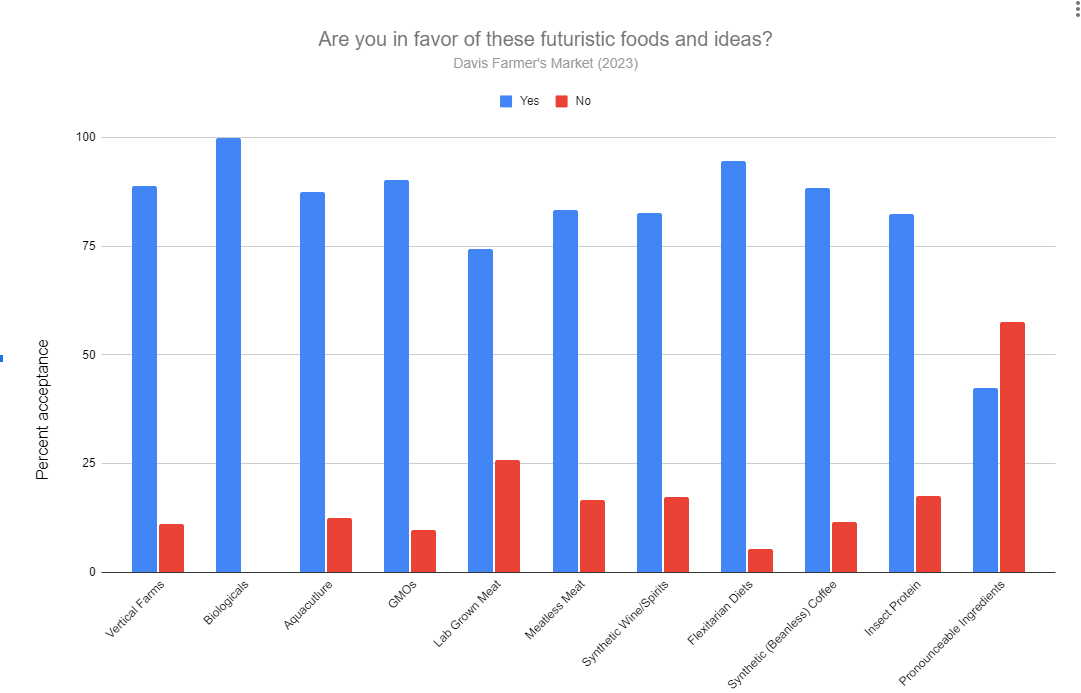
The Future of Food... Again!
Science Says Returns to the Davis Farmer's Market
Quick Summary
- Science Says kicked off its return to the Davis farmer's market in January 2023 with a "Future of Food" display polling passersby on their opinions of futuristic foods.
Our future looks delicious... Or does it? The technology surrounding developing new food products is evolving quickly and hurdling us towards a world of cell-based meat and beanless coffee. As consumer interest in sustainable food production and products continues to grow, several companies have risen to the challenge of developing climate-conscious (but still palatable!) consumables. But how will these new products be perceived? Can a coffee lover be convinced to try out beanless coffee made from date pits? Science Says member and longtime science communicator with a passion for sharing new food technologies with the public, Mary Madera, has been polling people’s opinions on futuristic foods for several years. Starting in 2018, she collected opinions at not one, but four (!) CLEAR outreach events. She debuted the Future of Food polling at the Davis Farmer’s Market in 2019, and after a brief pandemic-induced hiatus, we brought the exhibit back in January of 2023.
The topics featured were (full definitions at the end):
- Vertical Farms
- Biologicals
- Aquaculture
- Genetically modified organisms (GMOs)
- Lab Grown (Cultured) Meat
- Meatless Meat
- Synthetic Wine/Spirits
- Flexitarian Diets
- Synthetic (Beanless) Coffee*
- Insect Protein**
- Pronounceable Ingredients**
* Introduced at the Davis Farmer’s Market in 2019
** Introduced at the Davis Farmer’s Market in 2023

To gauge the public’s opinions of these topics, we set up signs with brief, neutral descriptions of each topic and asked people to vote yes or no using beans they dropped into spice jars. Several participants asked us to explain was voting for or against a topic really meant - were we asking if they were willing to try synthetic wine? Or were we asking if they thought insect protein was going to be a popular, viable product and the future of protein supplements? We explained that the meaning of voting “yes” or “no” was open to interpretation and purposefully vague, thus encouraging participants to share their thought processes. Some passersby voted based on whether they would try the products or at least found them interesting, while others focused on economic viability and if the products would succeed in the market.
Overall, the Davis community greatly supports these futuristic food and agriculture innovations. Biologicals took the lead with 100% support, whereas pronounceable ingredients were the most contentious. The majority of participants did not support that an ingredient needed to be pronounceable to be safe for consumption, but others liked the idea of recognizing the words listed under ingredient labels.


We also encouraged people to answer our free-write question: what does the future of food look like to you? Some are looking forward to different agricultural innovations, whereas others are dreaming of novelty products such as lab-grown meat from exotic or extinct animals. Which of these responses do you agree with?
Since breaking back into the farmer’s market scene in January, Science Says has debuted several brand new topics, including crop domestication and evolution, atmospheric rivers, and seeds. We’re taking a break from tabling for the summer to stay cool and prepare new topics but we’re excited to see you all again in the fall!
Topic definitions:
- Vertical farms - Goal: Grow food using the smallest amount of land possible. Can grow food locally with reduced water, runoff, emissions, & higher nutrient produce.
- Biologicals - Goal: Use microorganisms to replace chemical fertilizers and pesticides to increase crop yields.
- Aquaculture - Goal: Allow wild populations to regenerate and meet seafood demands by creating sustainable domesticated fish farms in open waters.
- Genetically modified organisms (GMOs) - Goal: Create crops that are higher in nutrients, easier to grow, or more resistant to pests and drought.
- Lab grown meat - Goal: Real meat is grown in a lab, reducing the number of livestock needed to keep up with a growing global population.
- Meatless meat - Goal: Create plant-based products that taste like meat but don’t require raising and killing animals.
- Synthetic wine/spirits - Goal: Produce spirits from grain neutral alcohols without fermenting grapes and/or aging the product reducing time, water, land-use, and emissions.
- Flexitarian diets - Goal: Incorporating more vegetarian proteins, like a variety of nutritious beans, into your diet and eating less meat.
- Synthetic coffee ** (introduced at Davis Market in 2019) Goal: Create coffee-like beverages without coffee beans reducing water, deforestation, carbon emissions, and resources (use upcycled date pits).
- Insect Protein** (introduced at Davis Market in 2023) Goal: Incorporate insect protein into diets to reduce water, land use, and resources as compared to meat; is a complete protein compared to plants.
- Pronounceable Ingredients** (introduced at Davis Market in 2023) Goal: Eat foods with simple and/or pronounceable ingredient lists.

Comments